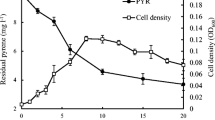Summary
Alcaligenes sp. A 7-2 immobilized on granular clay has been applied in a percolator to degrade 4-chlorophenol in sandy soil. Good adsorption rates on granular clay were achieved using cell suspensions with high titres and media at pH 8.0. The influence of various parameters such as aeration rate, pH, temperature, concentration of 4-chlorophenol and size of inoculum on the degradation rate were investigated. During fedbatch fermentations under optimal culture conditions, concentrations of 4-chlorophenol up to 160 mg·1−1 could be degraded. Semicontinuous culture experiments demonstrated that the degradation potential in soil could be well established and enhanced by the addition of immobilized bacteria. Continuous fermentation was performed with varying 4-chlorophenol concentrations in the feed and different input levels. The maximum degradation rate was 1.64 g·1−1·day−1.
Similar content being viewed by others

References
Apajalahti JHA, Salkinoja-Salonen MS (1986) Degradation of polychlorinated phenols by Rhodococcus chlorophenolicus. Appl Microbiol Biotechnol 25:62–67
Balfanz J (1988) Abbau von 4-Cl-Phenol durch immobilisierte Bakterien im Modellboden. Diploma-Thesis, University of Münster
Crawford RL, Mohn WW (1985) Microbiological removal of pentachlorophenol from soil using a Flavobacterium. Enzyme Microb Technol 7:617–620
Dorn E, Knackmuss HJ (1978) Chemical structure and biodegradability of halogenated aromatic compounds. Two catechol 1,2-dioxigenases from a 3-chlorobenzoate-grown pseudomonad. Biochem J 174:73–84
Ehrhardt HM, Rehm HJ (1985) Phenol degradation by microorganisms adsorbed on activated carbon. Appl Microbiol Biotechnol 21:32–36
Ehrhardt HM, Rehm HJ (1989) Semicontinuous and continuous degradation of phenol by Pseudomonas putida P 8 adsorbed on activated carbon. Appl Microbiol Biotechnol 30:312–317
Gerson DF, Zajic JE (1979) The biophysics of cellular adhesion. In: Venkatasubramanian K (ed) Immobilized microbial cells. ACS Symp Ser 106:29–57
Hanson RS, Phillips JA (1981) Chemical composition. In: Gerhardt P, Murray RGE, Costilow RN, Nester EW, Wood WA, Krieg NR, Phillips GB (eds) Manual of methods for general bacteriology. Am Soc Microbiol, Washington DC, pp 358–359
Keweloh H, Heipieper HJ, Rehm HJ (1989) Protection of bacteria against toxicity of phenol by immobilization in calcium alginate. Appl Microbiol Biotechnol 31:383–389
Leisinger T, Brunner W (1986) Poorly degradable substances. In: Rehm HJ, Reed G, Schönborn W (eds) Biotechnology, vol 8. Microbial degradations. VCH, Weinheim, pp 475–513
Li AYL, DiGiano FA (1983) Availability of sorbed substrate for microbial degradation on granular activated carbon. J WPCF 55 (4):392–399
Lowry OH, Rosenbrough NJ, Lewis Farr A, Randall RJ (1951) Protein measurement with the Folin phenol reagent. J Biol Chem 193:265–275
Martin RW (1949) Rapid colorimetric estimation of phenol. Anal Chem 21:1419
Molin G, Nilsson I (1985) Degradation of phenol by Pseudomonas putida ATCC 11 172 in continuous culture as different ratios of biofilm surface to culture volume. Appl Environ Microbiol 50:946–950
Mörsen A, Rehm HJ (1990) Degradation of phenol by a defined mixed culture immobilized by adsorption on activated carbon and sintered glass. Appl Microbiol Biotechnol 33:206–212
Omar SH, Rehm HJ (1988) Degradation of alkanes by Candida parapsilosis and Penicillium frequentans immobilized on granular clay and aquifer sand. Appl Microbiol Biotechnol 28:103–108
Pfennig N, Lippert KD (1966) Über das Vitamin B12-Bedürfnis phototropher Schwefelbakterien. Arch Microbiol 55:245–256
Schwien U, Schmidt E (1982) Improved degradation of monochlorophenols by a constructed strain. Appl Microbiol Biotechnol 44:33–39
Westmeier F, Rehm HJ (1985) Biodegradation of 4-chlorophenol by entrapped Alcaligenes sp. A 7–2. Appl Microbiol Biotechnol 22:301–305
Westmeier F, Rehm HJ (1986) Einsatz von Immobilisationsverfahren zum biologischen Abbau chlorierter Phenole. Chem Ind 3:158–160
Westmeier F, Rehm HJ (1987) Degradation of 4-chlorophenol in municipal wastewater by adsorptive immobilized Alcaligenes sp. A 7–2. Appl Microbiol Biotechnol 26:78–87
Author information
Authors and Affiliations
Additional information
Offprint requests to: H.-J. Rehm
Rights and permissions
About this article
Cite this article
Balfanz, J., Rehm, HJ. Biodegradation of 4-chlorophenol by adsorptive immobilized Alcaligenes sp. A 7-2 in soil. Appl Microbiol Biotechnol 35, 662–668 (1991). https://doi.org/10.1007/BF00169634
Received:
Accepted:
Issue Date:
DOI: https://doi.org/10.1007/BF00169634



